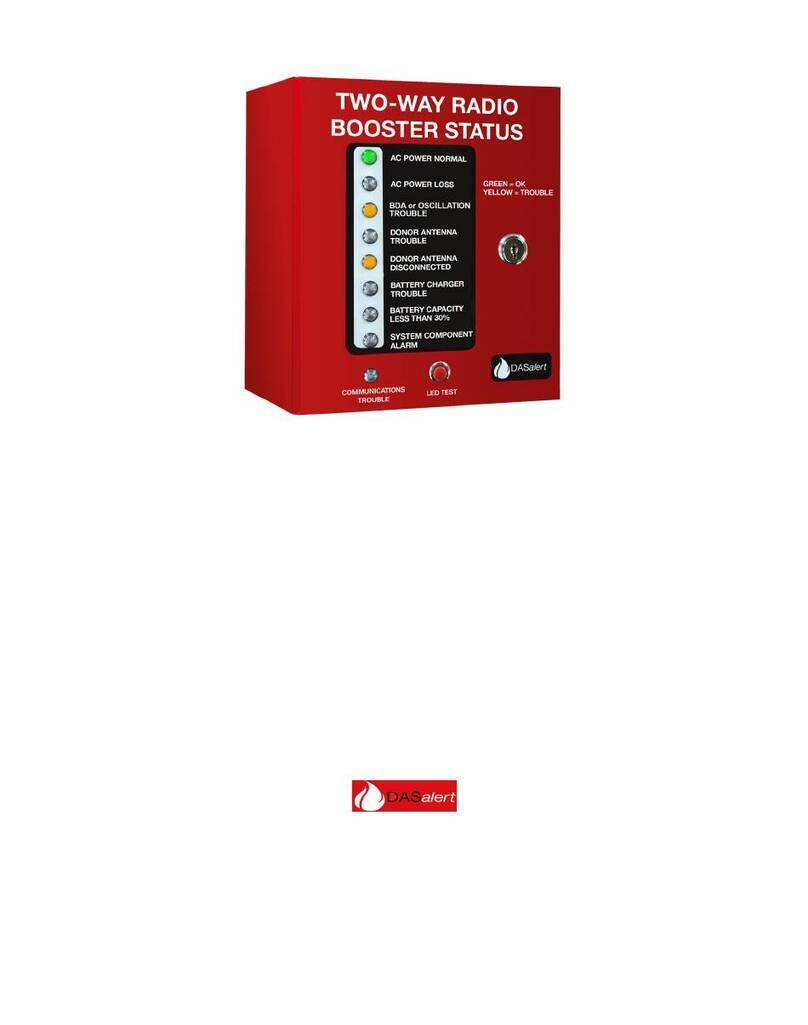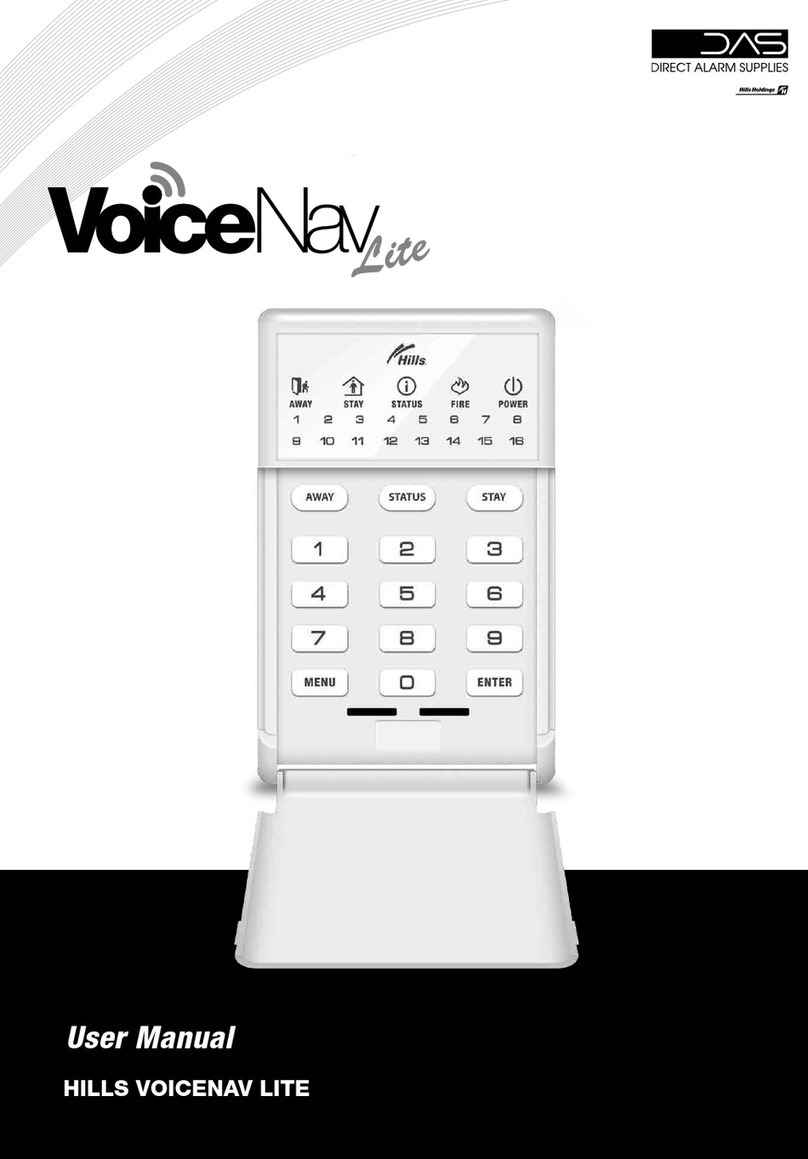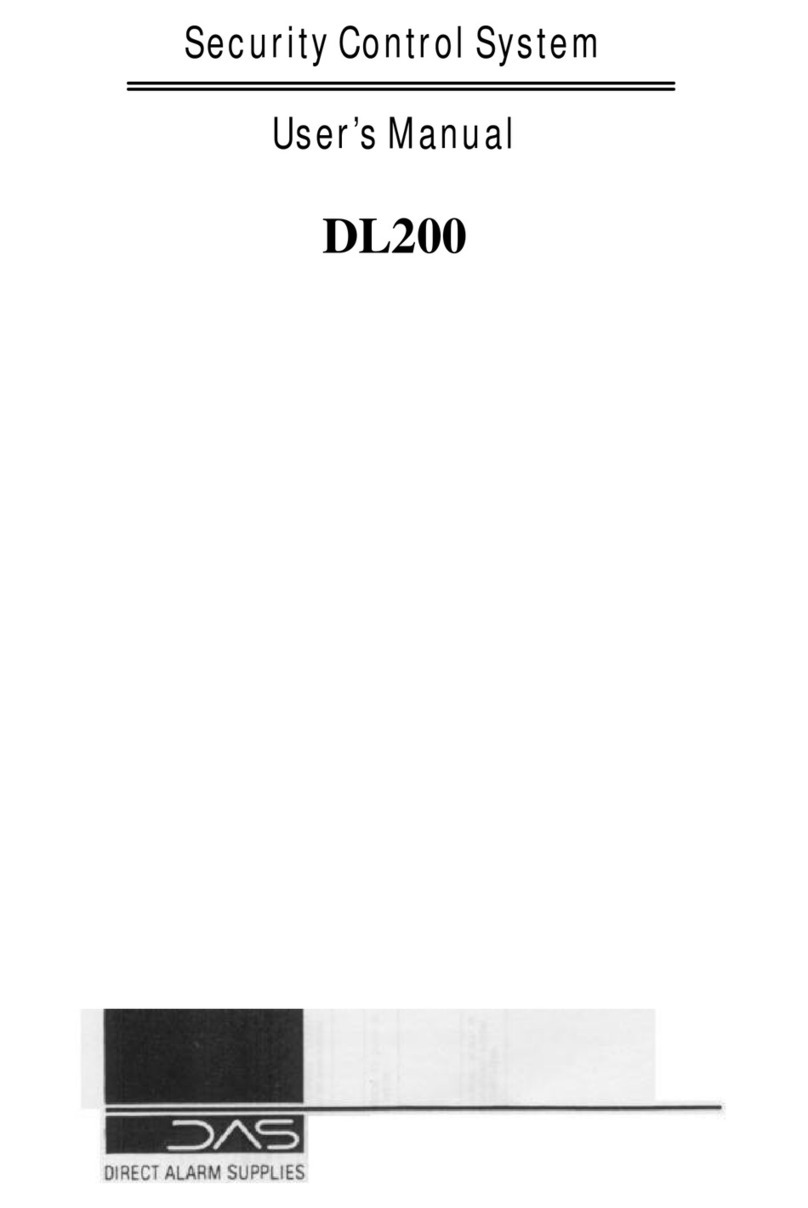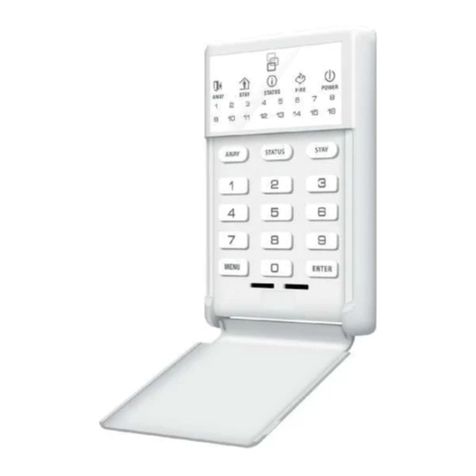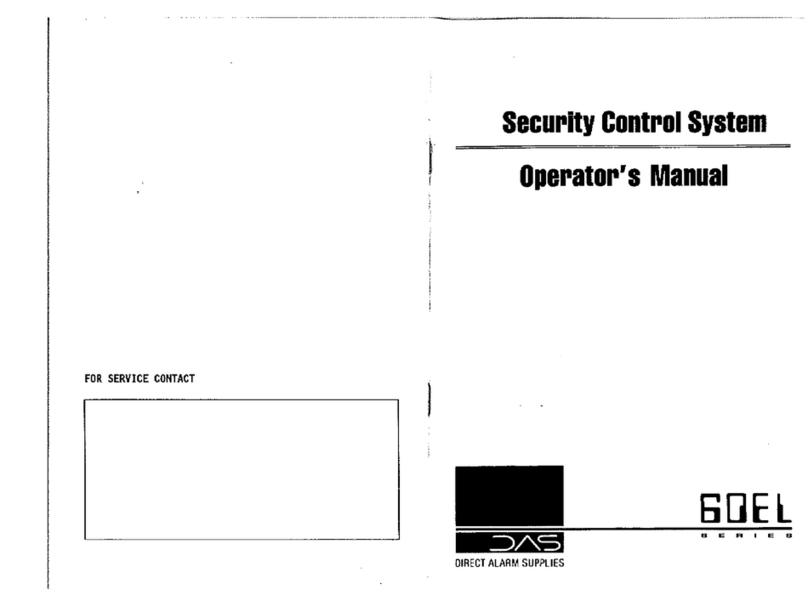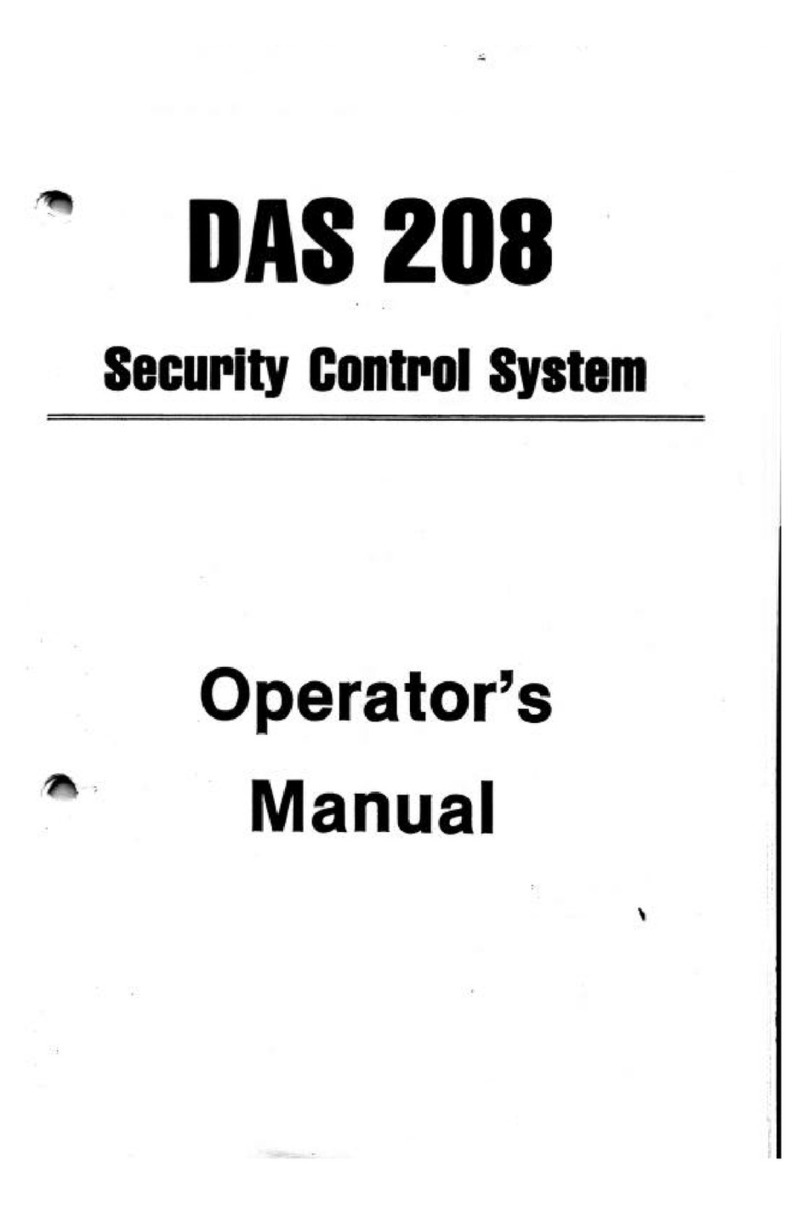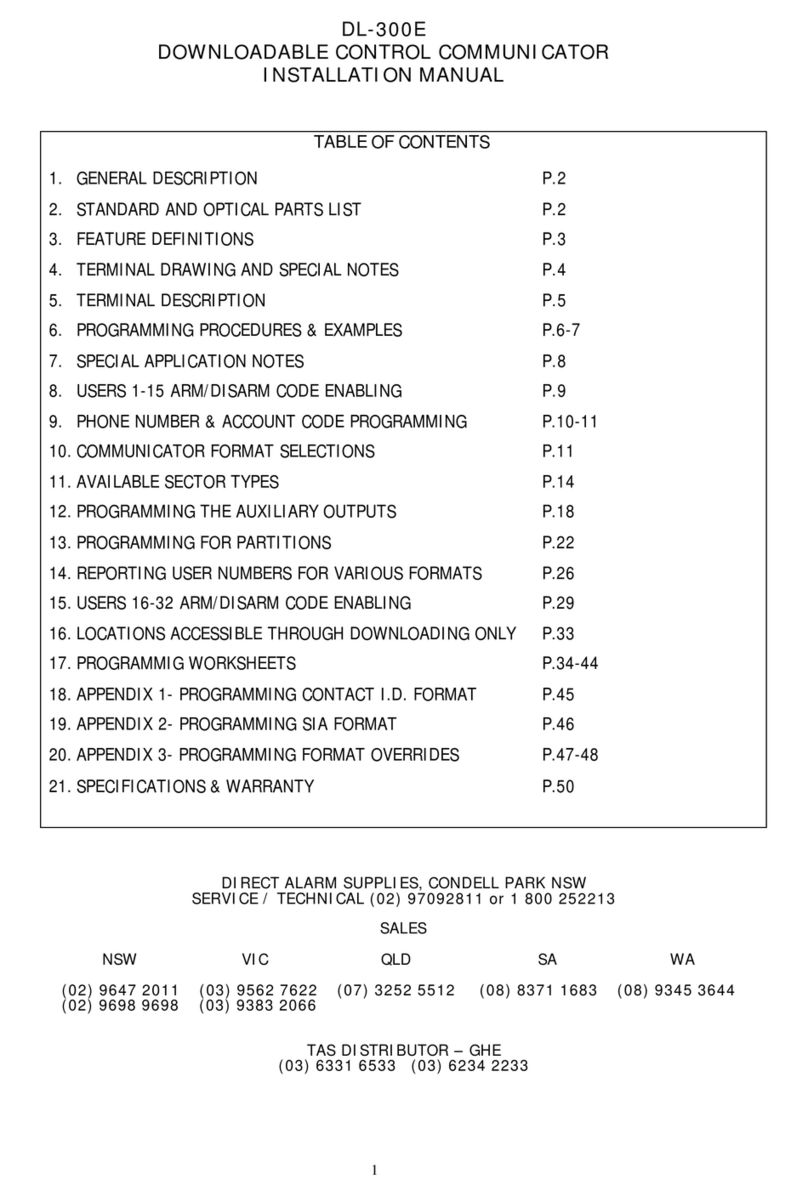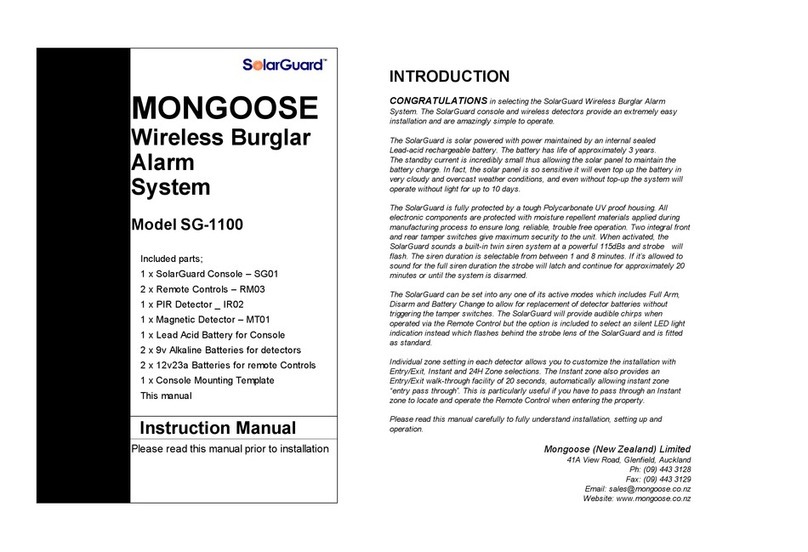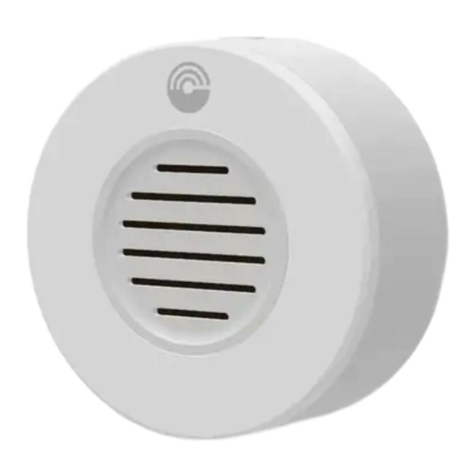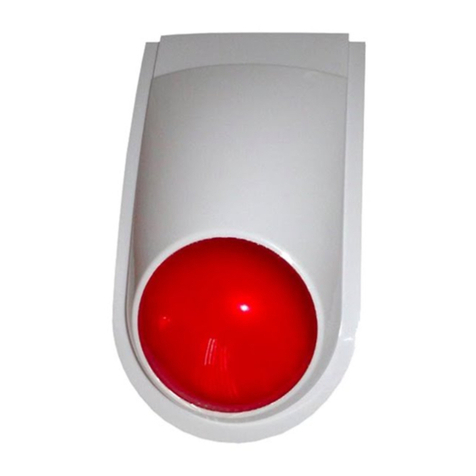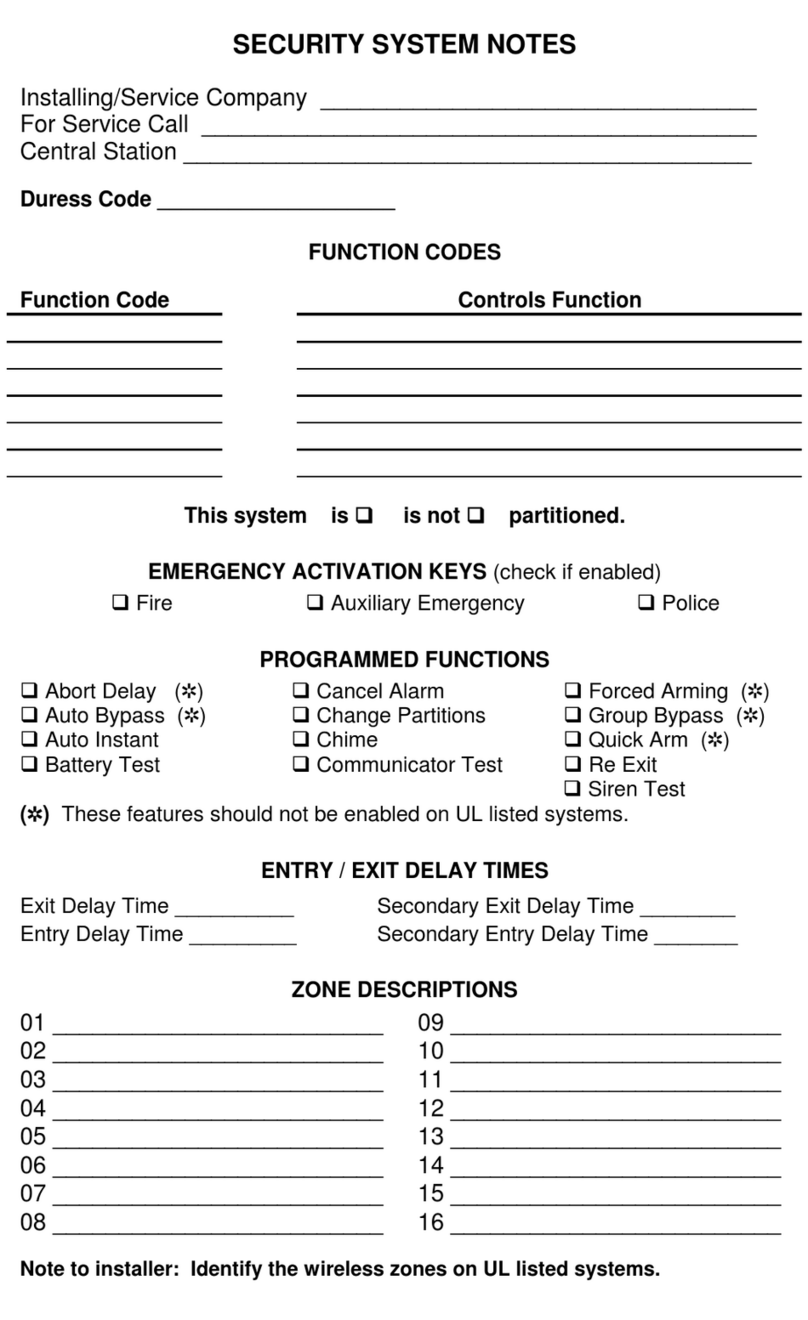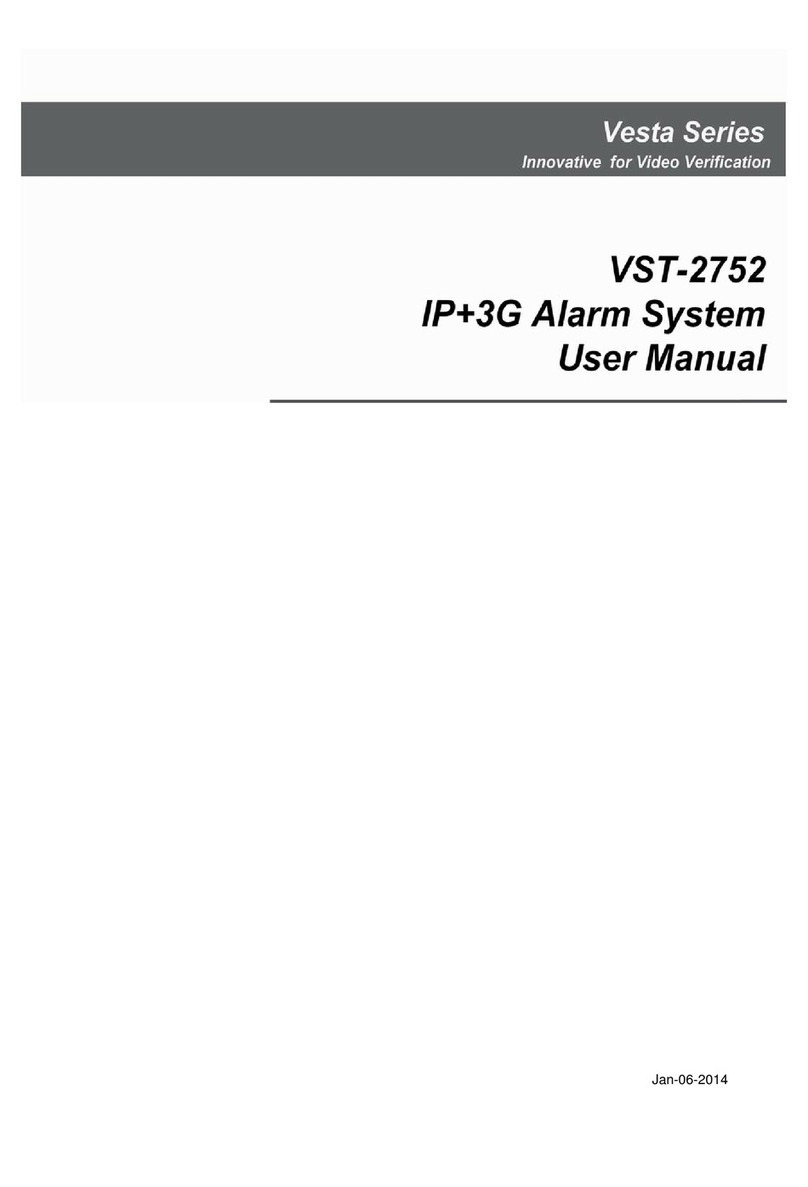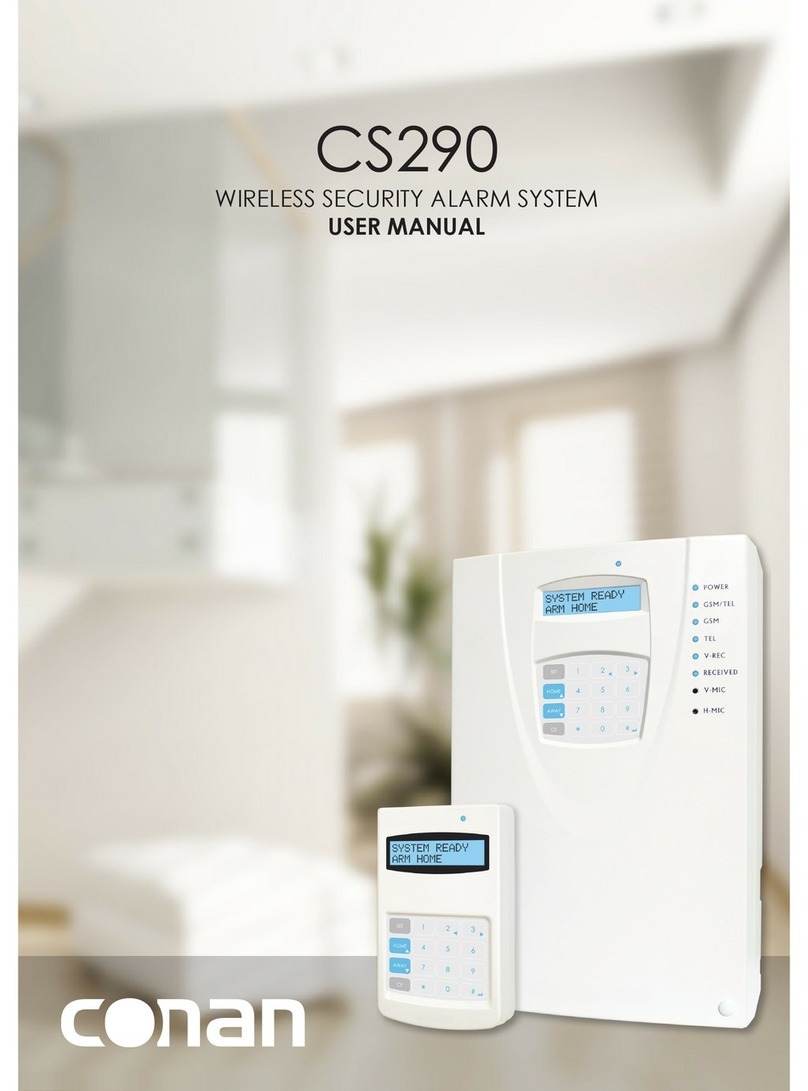DAS DL100 User manual

1
SECURITY SYSTEM NOTES
Installing/Service Company
For Service Call
SPECIAL CODES
"Chime" Digit
1
"Partial Arm" Digit
2
"Quick Arm" Digit
3
ENTRY / EXIT DELAY TIMES
Exit Delay Time Secondary Exit Delay Time
Entry Delay Time Secondary Entry Delay Time
Partial Arm Warning Time
ARM / DISARM CODES
Master Code/User # 01 02 03
04 05 06 07
08 09 10 11
12 13 14 15
ZONE DESCRIPTIONS
1 2
3 4

2
5 6
THIS MANUAL IS FURNISHED TO HELP YOU UNDERSTAND YOUR SECURITY SYSTEM
AND BECOME PROFICIENT IN ITS OPERATION. ALL USERS OF YOUR SECURITY
SYSTEM SHOULD READ AND FOLLOW THE INSTRUCTIONS AND PRECAUTIONS IN
THIS BOOKLET. FAILURE TO DO SO COULD RESULT IN THE SECURITY SYSTEM NOT
WORKING PROPERLY. THIS BOOKLET SHOULD BE KEPT IN AN ACCESSIBLE
LOCATION FOR THE LIFE OF THE SECURITY SYSTEM. IF YOU DO NOT UNDERSTAND
ANY PART OF THIS MANUAL YOU SHOULD NOTIFYYOUR INSTALLINGCOMPANY AND
ASK FOR THAT SECTION OF THE MANUAL TO BE EXPLAINED FULLY.
The SECURITY CONTROL CENTER is turned on (Armed) and off (Disarmed) by entering a 4
digit code into the Code Pad Control, which is similar to a telephone code pad. The Code Pad
Control includes 11 lights and a built in electronic sounder. These provide specific information
relating to the status of the security system which is described in this booklet. Understanding
what the lights and sounds mean will help you to easily operate your system.
SO REMEMBER, READ THE ENTIRE MANUAL, AND, IF POSSIBLE PRACTICE ON THE
CODE PAD CONTROL WHILE YOUR PROFESSIONAL INSTALLER IS AT YOUR
BUILDING. IF YOU HAVE ANY QUESTIONS ASK YOUR INSTALLING COMPANY.
PLEASE KEEP IN MIND THAT THE LEVEL OF SECURITY YOU WILL OBTAIN WITH THIS
SYSTEM RELATES SPECIFICALLY WITH TWO MAJOR FACTORS:
1. The quantity, quality, and placement of security devices attached to this system.
2. The knowledge you have of the security system and how that knowledge is utilized in a
weekly test of the complete system.
YOU SHOULD BE AWARE OF THE FOLLOWING FACTS WHEN PREPARING A
SAFETY/SECURITY PLAN FOR YOUR HOME/BUSINESS.
1. Your security system is an electronic device and is subject to failure or malfunction. Do
not rely on it as your single source of security.
2. Your system should be tested weekly.
3. Your system will not work without power.
4. Warning devices will need to be loud enough, wired correctly, and properly placed to
provide notification of an alarm event.
5. Smoke and heat detectors may not detect heat and smoke in all situations.
6. Use qualified security professionals to select, install, and maintain your security system.
7. It may be possible to arm the security system without the backup battery connected. Your
periodic test should be done with A.C. Power removed to verify the battery is connected
and adequately charged.
8. Care should be taken to plug in and properly restrain the A.C. Transformer after testing.

3
PLEASE READ THIS ENTIRE BOOKLET CAREFULLY BEFORE OPERATING YOUR
SECURITY CONTROL SYSTEM. IF YOU DO NOT UNDERSTAND ANY PORTION OF THIS
MANUAL, OR IF YOU HAVE ANY QUESTIONS ABOUT YOUR SYSTEM, CONTACT THE
INSTALLING COMPANY LISTED ON PAGE 1 OF THIS BOOKLET.

4
HOW TO ARM YOUR SECURITY SYSTEM
To Arm the security system, close all of the protected doors and windows. The green "READY"
light on the code pad control will be illuminated when all of the protected zonesandsensorsare
secure. If any of the zones are isolated, a sensor in that zone can be violated without affecting
the "READY" light. The security system will not arm if the "READY" light is not illuminated.With
the "READY" light on, you may arm the security system with your Master Code or one of the
auxiliary codes. Each time a key is pressed on the code pad control, a short tone (beep) will
sound. If the code pad beeps three times after a code entry, it is an indication that the code has
not been accepted. Press the [#] key (reset) and re-enter a valid code. If the code pad control
beeps continuously after code entry, it is an indication that the "POWER" light is off. The code
pad sounder can be silenced by re-entering your four digit code. If the "POWER"lightisoff,you
should restore power to the system if possible. When the security system has accepted a valid
code, the red "ARMED" light will illuminate indicating that the system has beenturnedon.Ifyou
choose to leave the protected area, you must exit within the exit delay time. If you choose to
stay within the protected area, insure that all interior zones which may be tripped by your
movement are isolated.
HOW TO DISARM YOUR SECURITY SYSTEM
When you enter the protected area through one of the designated entry/exit doors, the code
pad control will sound a continuous tone (beep) for the duration of the entry delay time, oruntil
you enter a valid code. After a valid code has been entered, the red "ARMED" light will turn off,
and the tone will stop. The security system is now DISARMED (off). If a valid code is not
entered before the end of the entry delay time, an alarm will occur. (NOTE: IF THE RED
"ARMED" LIGHT IS FLASHING DURING THE ENTRY DELAY, THE ALARM SYSTEM HAS
BEEN ACTIVATED IN YOUR ABSENCE. LEAVE THE BUILDING IMMEDIATELY AND CALL
YOUR ALARM COMPANY AND/OR THE POLICE.)
ALARM MEMORY
To review the previous alarm, press [0] and wait 5 seconds. The zones that were activated
during the last alarm will flash for 5 seconds. This condition will stay in memory until the next
alarm activation.
HOW TO ISOLATE ZONES
To isolate any of the zones, press [], zone number(s) to be isolated (1 thru 6), and [].Zones
cannot be isolated or de-isolated while the control is armed. When the security system is
disarmed, all isolated zones will be de-isolated. As isolated zones are not protected, this
procedure should only be given to authorized persons. For example, to isolate zone 1, the
sequence would be as follows:
[] - [1] - []
To isolate zones 1, 3, and 4, the sequence would be as follows:
[] - [1] - [3] - [4] - []
QUICK-ARM FEATURE
If this box is checked, your security system will have the [3] key "QUICK ARM" code

5
programmed. This feature will allow you to arm the security system by pressing one, pre-
designated key on the code pad control. This "QUICK ARM" code is for ARMING ONLY, and
will not disarm the security system. This makes it ideal for a maid code, babysitter code, etc.
This code can only be programmed and/or changed by your installing company.
PARTIAL ARM ARMING
If this box is checked, your installing company has selected the "Partial Arm" feature for your
security system. "Partial Arm" allows "At Home" system arming for added security. To usethis
feature, press the [2] key on the code pad control. After 5 seconds the "ARMED" and
"PARTIAL" lights on the Code pad Control will be illuminated, indicating that your Security
System has entered the "Partial Arm" mode. When selected, the following listed zones will be
isolated , and all other zones will cause the code pad buzzer only to sound for
seconds before the system siren is activated and the alarm signal istransmittedtoa Base
Station (if your security system is monitored by a Base Station). This allows you to reset your
security system prior to it reaching an emergency stage in the event of an accidental zone
violation. To turn this feature off, enter your four digit code at the code pad control. The
"Armed" and "Partial" lights on the code pad control will go out and the securitysystem willbein
a full disarmed condition.
AUTOMATIC ARMING OPTION
If this box is checked, the "Automatic Arming" option has been selected by your installing
company. This feature is used to make your system automatically arm itself at a designated
time of day if it is not already armed. The code pad will sound a continuous tone for a 50
second time frame before automatically arming. If a validcodeisenteredduring thistimeframe,
the system will not automatically arm. When automatic arming occurs, all zones that are not
secure, will become isolated. Automatic arm may also be programmed to arm your system in
the Partial Mode.
AUTOMATIC ISOLATE OPTION
If this box is checked, the "AUTOMATIC ISOLATE" feature has been selectedbyyourinstalling
company. With this feature enabled, your security system can be armed with any or all zones
violated. Any violated zone which does not return to a normal state by the end of the exit delay
time will be automatically isolated. Caution shouldbeusedwhenarmingyoursecuritysystemto
insure that zones necessary for minimal, or desired protection levels are not violated, and thus
isolated from the security system. Automatic isolation may also be programmed so that only
the exit zones may be faulted before arming can occur.
GROUP ISOLATE OPTION
If this box is checked, the "GROUP ISOLATE" option has been selected by your installing
company. If you wish to isolate all zones designated as "GROUP ISOLATE"zones, youmaydo
so by pressing the [] key during the exit delay. Once these zones have beenisolated, theywill
remain isolated until the system is disarmed. Once "GROUP ISOLATE" zones have been
isolated, the "AUTOMATIC ISOLATE" option will not take effect for this arming time..

6
TURNING ON THE CHIME FEATURE
If this box is checked, your security system will operate in the "CHIME" mode, allowing the
monitoring of pre-designated zones while the security system is not armed. While in the
"CHIME" mode, the opening of any of these zones will produce a tone from the code pad
control. To activate this feature, press the "CHIME" digit which is noted on page 1 of this
manual. Five seconds after pressing this digit, a tone will occur indicating that the "CHIME"
feature has been activated. Repeat this procedure to turn the "CHIME" feature off.
MANUAL CODE PAD PANIC / HOLD-UP ALARM
If this box is checked, the "MANUAL PANIC/HOLD-UP" option has been selected. When
selected, pressing the star [] and hatch [#] keys at the same time for one second, willsounda
local audible alarm. If your system is connected to a monitoring center, an emergency report
could be transmitted to that centre. These keys should only be pressed in an emergency
situation requiring immediate response by law enforcement personnel.
PLEASE NOTE: Some Panic/Hold-up alarms are programmed to be silent at the protected
building while reporting an alarm to the monitoring centre. Check with your installing company
to determine how your security system will respond to the Panic/Hold-up input.
MANUAL CODE PAD FIRE ALARM
If this box is checked, the "MANUAL FIRE ALARM" option has been selected by your installing
company. If so, you can activate the steady siren by pressing the [1] and [3] keys at the same
time for one second. If your system is connected to a monitoring centre, an emergency report
could be sent to that centre. These keys should only be pressed in an emergency situation
requiring response by fire department personnel.
MANUAL CODE PAD MEDICAL ALARM
If this box is checked, the "MANUAL MEDICAL ALARM" feature has been selected by your
installing company. If so, you can activate the auxiliary alarm by pressing the four [4]andsix[6]
keys at the same time for one second. If your system is connected to a monitoring centre, an
emergency report could be sent to that centre. These keys should only be pressed in an
emergency situation requiring response by emergency personnel.
DURESS CODE
If this box is checked, your security system has a "DURESS CODE" option. If so, thiscodemay
be programmed to send a special message to the central monitoring station if you are forcedto
arm or disarm your security system against your will. Check with your
Installing/Servicing company to see if this option has been enabled for your system.
TELEPHONE LINE MONITOR
If this box is checked, your installing company has selected the TELEPHONE LINE MONITOR
which will monitor the telephone line that links your security system to the monitoring station.
When selected, the loss of this telephone line will flash the "READY" light while giving either

7
immediate, or delayed audible notification by sounding the siren and/or code pad sounder.
Check with the installing company listed on page 1 to find out if notification will be delayed or
immediate, and what kind of sound will be created in case of a telephone line fault.

8
PROGRAMMING ARM / DISARM CODES
Your security system can be armed and disarmed by the Mastercode(User Code#1)andup to
7 auxiliary codes. All codes must have 4 digits. These Auxiliary codes are individually
numbered from 2 to 7 (User code 7 may be reserved for an optional Duress code, see page 5
under "DURESS CODE"). If Auxiliary codes are desired, they must be programmed
individually. Only persons knowing the Master code can assign or change auxiliarycodes(see
programming Auxiliary codes below).
CHANGING THE MASTER CODE - The master code is user code #1, and must be referred to
by its number. For example, if the Master code is [1]-[2]-[3]-[4] and you want to change it to [5]-
[3]-[4]-[2], the sequence would be as follows: Press []-[1]-[#](thisentersprogrammingforuser
#01), then [1]-[2]-[3]-[4] (the old Master code), then []-[1]-[#] , then [5]-[3]-[4]-[2] (new Master
code) then []-[1]-[#]. The entire sequence would consist of pressing the17 keysshownbelow.
[]-[1]-[#] - [1]-[2]-[3]-[4] - []-[1]-[#] - [5]-[3]-[4]-[2] - []-[1]-[#]
(Code 01) (Master Code) (New Code)
PROGRAMMING AUXILIARY CODES - In order to program Auxiliary Codes you must know
the Master code. As stated earlier, each auxiliary code has its own unique number from 2to15.
It is programmed much like the Master Code. For example, to programAuxiliaryusercode#12,
the sequence would be as follows:
[]-[1]-[2]-[#] - [5]-[3]-[4]-[2] - []-[1]-[2]-[#] - [6]-[7]-[8]-[9] - []-[1]-[2][#]
(Code 12) (Master Code) (New Code)
REMOVING AUXILIARY CODES - To remove an Auxiliary user code, simply program that
code with the same code as the master code (01). For example, to remove user code #5, the
sequence would be as follows:
[]-[1]-[2]-[#] - [5]-[3]-[4]-[2] - []-[1]-[2]-[#] - [5]-[3]-[4]-[2] - []-[1]-[2]-[#]
(Code 5) (Master Code) (Master Code)
USER PROGRAMMABLE TELEPHONE NUMBERS
When pager or siren tone formats are selected, any of the DL100's three phone numbers may
be programmed or altered in the run mode. The process would consist of entering the phone
number via the LED or LCD code pads with a read back facility only on the LED code pad.
The selection of Tone or Pulse dialing must be made via the normal programming methods,
therefore, the installer would program this selection during installation. You must use the
following procedure to enter and review your phone numbers.
PROGRAMMING PHONE NUMBERS
In the run mode and only while the DL100 is disarmed :
Press [
] [6] [1] [#] [MASTER CODE] [#]
(To enter the programming sequence for phone number one)
Press [
] [6] [2] [#] [MASTER CODE] [#]
(To enter the programming sequence for phone number two)

9
Press [
] [6] [3] [#] [MASTER CODE] [#]
(To enter the programming sequence for phone number three)
Now enter the required number, not exceeding 16 digits for pulse dialing or 15 digits for tone
dialing.
Enter Phone Number. Example: [9] [7] [0] [7] [4] [3] [1] [1] [
] (the is a 4 second pause).
Finally enter [#] to mark the end of your programming sequence.
The full sequence for entering the phone number 97074311 into phone number one, with a
four second pause is as follows:
[] [6] [1] [MASTER CODE] [#] [9] [7] [0] [7] [4] [3] [1] [1] [
] [#]
REVIEWING PHONE NUMBERS IN THE RUN MODE
Once the [#] is pressed to mark the end of the phone number, the DL100will thenreadback the
entered number, (ignoring 15's and 13's) displaying it on the LED code pad.
The numbers will be represented by the LED’s on the LED code pad. Zone LEDs 1 to 6 will
represent digits 1 to 6. The Armed LED will represent digit 7, the ready LED will represent digit
8, the Partial LED will represent digit 9, and the Power LED will represent digit 0. Refer to the
table below for details:
CODE PAD
LEDS
PHONE DIGIT
CODE PAD
LEDS
PHONE DIGITS
Armed
7
Zone 1
1
Ready
8
Zone 2
2
Partial
9
Zone 3
3
Power
0
Zone 4
4
Zone 5
5
Zone 6
6
Each LED will turn on for 1 second and will have a 500mS delay between LEDs. To mark the
end of the display, all the LEDs will turn on for 200mS and the code pad will beep once.
To review a phone number without entering a new one into programming, press [] [6] [1] [#],
[][6][2] [#], or [] [6] [3] [#] followed by the master code and then pressing the [#] key. If you
have not entered a number, the existing number will be displayed.
DELETING PHONE NUMBERS
To delete a phone number, press [] [7] [1] [#] for phone number 1, [] [7] [2] [#] for phone
number 2, or [] [7] [3] [#] for phone number 3, followed bythe master code and then pressing
the [#] key. To mark a phone number deletion, all the LEDs will turn on for 200mSandthecode
pad will beep once.
RESETTING YOUR SECURITY CONTROL CENTER
In the event of a system malfunction in the Security Control Center, press the [#] (reset) key on
the code pad control. This should reset the code sequence and restore normal operation.Ifthe
problem persists, call the service number located on page 1 of this booklet for service.

10
AUDIBLE ALARM SOUNDS
FIRE Steady Siren
INTRUSION & PANIC Yelping siren
CODE PAD CONTROL LIGHT INDICATORS
ARMED RED: On when system is armed; off otherwise. Blinks as alarm memory if alarm
was activated during arming cycle.
READY GREEN: On when all zones are secure and/or isolated and the system is ready to
arm; off otherwise. Blinks for communicator trouble.
PARTIAL RED: On when "Partial Arm" is on; off otherwise.
TAMPER RED: On when "Box Tamper" is activated.
POWER RED: On when AC power is on; off otherwise. Blinks when the system standby
battery is low.
ZONES YELLOW: Blinking means unsecured. Steady means isolated. Off means secure.
CODE PAD CONTROL TONES (BEEPS)
A sounder is built into the code pad control and may sound for one of the following reasons:
Beeps for all keypresses.
Sounds a continuous tone during the Entry delay time, or Partial Arm delay time.
Pulses when a day zone is violated while the system is disarmed.
Pulses when a FIRE zone has a trouble condition.
Pulses when the armed status changes and the AC power is off.
Beeps 3 times for trying to arm with the "READY" light off, if "AUTOMATIC ISOLATE" has
not been selected.
Beeps 1 second for the "CHIME" feature.
Beeps 1 second at the end of the exit delay.
Beeps to indicate telephone line fault if selected.
When pulsing, the code pad sounder may be silenced by enteringavalidcode.Thearm/disarm
state of your system will not change when entering a code to silence a pulsing code pad
sounder.

11
EMERGENCY EVACUATION PLANS
An emergency evacuation plan should be established for an actual fire alarm condition. For
example, the following steps are recommended by the NationalFireProtection Associationand
can be used as a guide in establishing an evacuation plan for your building.
Draw up a floor plan of your home. Show windows, doors, stairs, and rooftops thatcan beused
for escape. Indicate each occupant's escape routes. Always keep these routes free from
obstruction.
Determine two means of escape from each room. One will be the normal exitfrom thebuilding.
The other may be a window that opens easily. An escape ladder may have to be located near
the window if there is a long drop to the ground below.
Set a meeting place outdoors for a headcount of the building occupants.
Practice escape procedures. In a home, sleep with bedroom door closed; this will increase
your escape time. If you suspect fire, test the door for heat. If you think it is safe, brace your
shoulder against the door and open it cautiously. Be ready to slam the door if smoke or heat
rush in. Practice escaping to the outdoors and meeting in an assigned spot.
NOTE: After the installation of your Security System has been completed, notify yourlocal Fire
and Police Departments to give them your name and address for their records.
Early warning fire detection is best achieved by the installation of fire detection equipmentin all
rooms.
The following are examples of evacuation plans. A plan unique to your home or business
should be drawn and memorized by each occupant.

FOR SERVICE CONTACT:
DL100 USER’S MANUAL
DL100UC98 REV C (09-25-98)
Table of contents
Other DAS Security System manuals
Popular Security System manuals by other brands
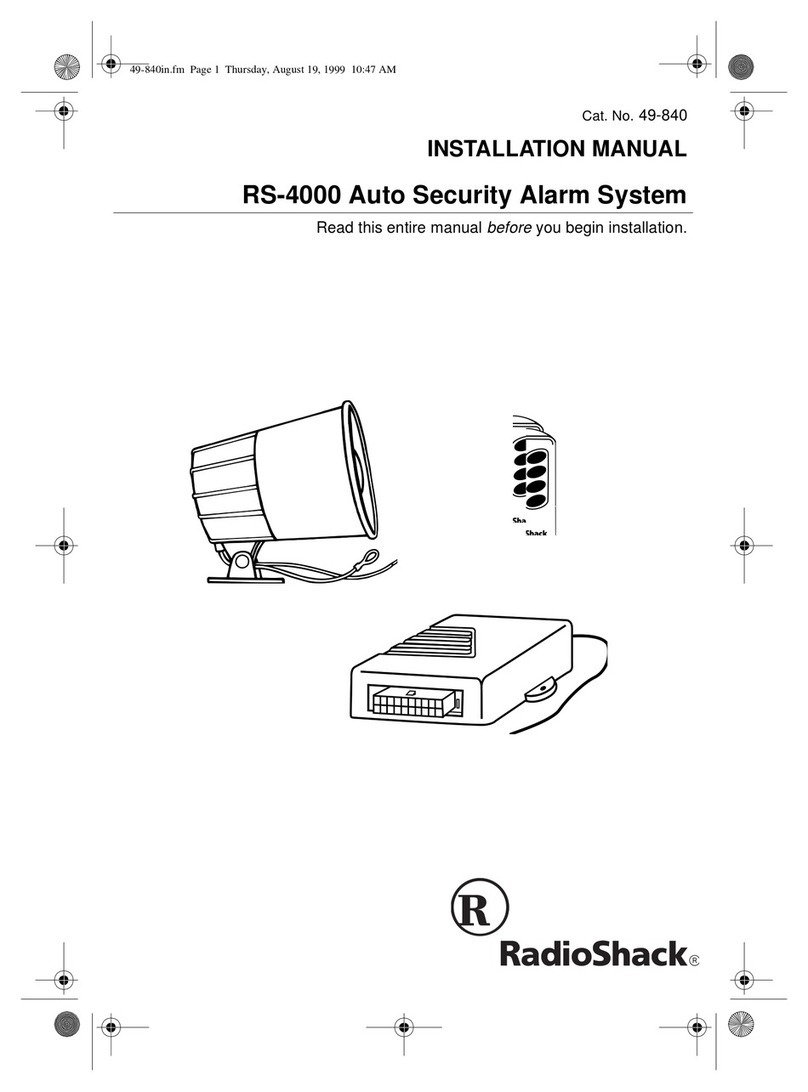
Radio Shack
Radio Shack RS-4000 installation manual
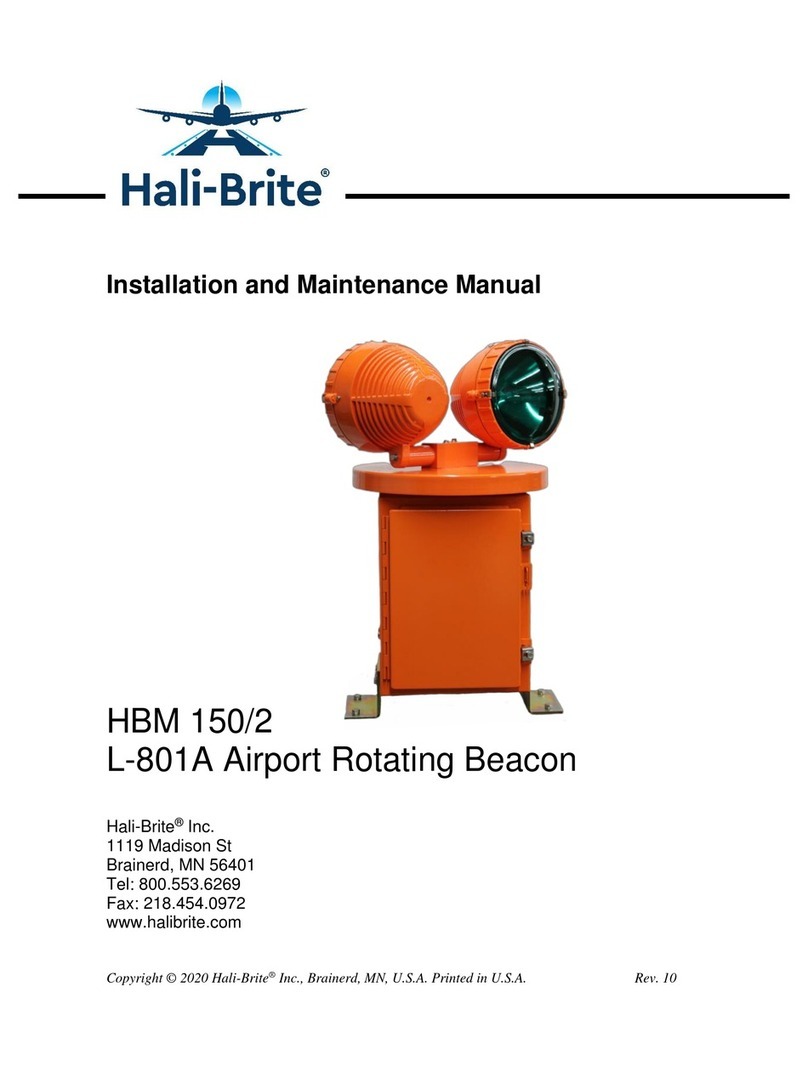
Hali-Brite
Hali-Brite HBM 150/2 L-801A Installation and maintenance manual
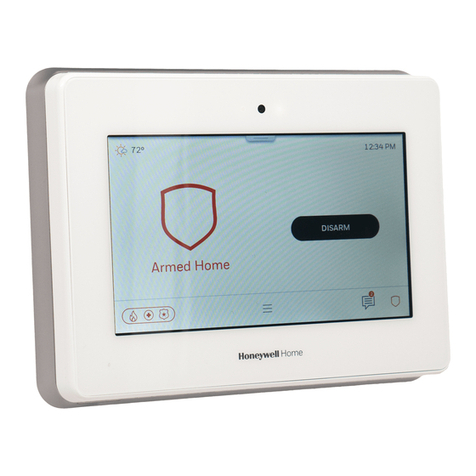
Honeywell Home
Honeywell Home PROA7PLUS Series Quick user guide
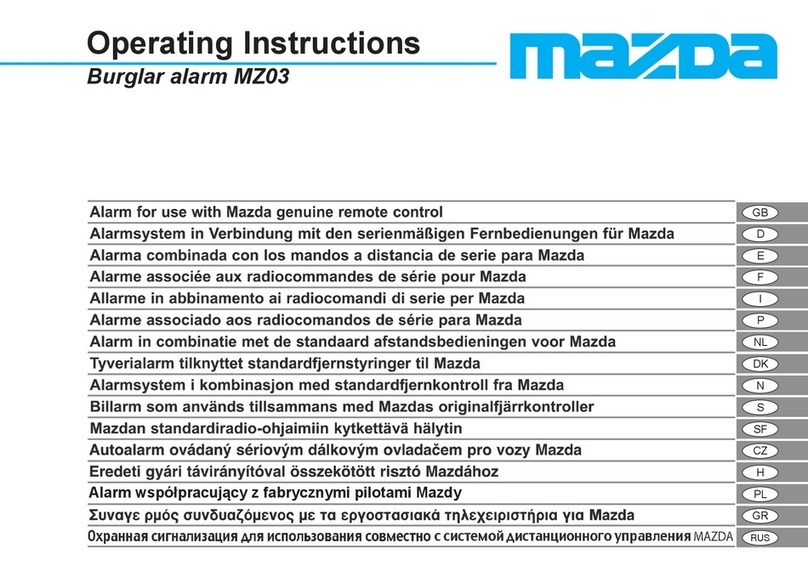
Mazda
Mazda MZ03 operating instructions
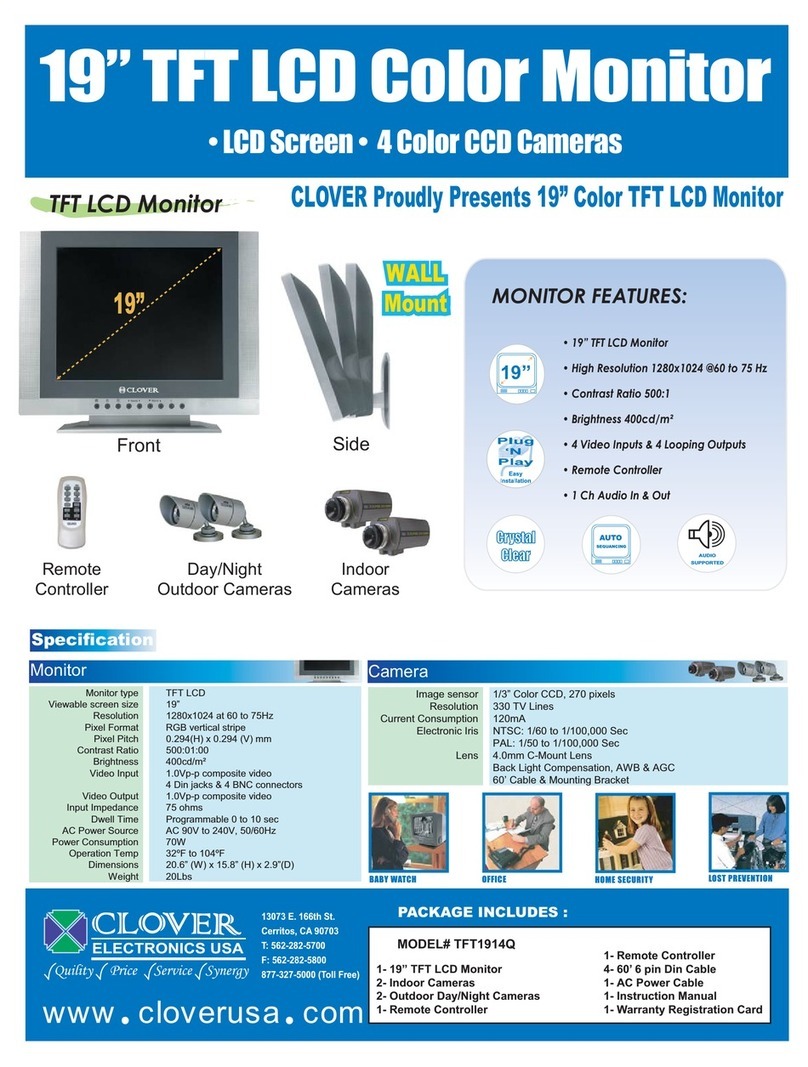
Clover
Clover TFT1914Q Specifications
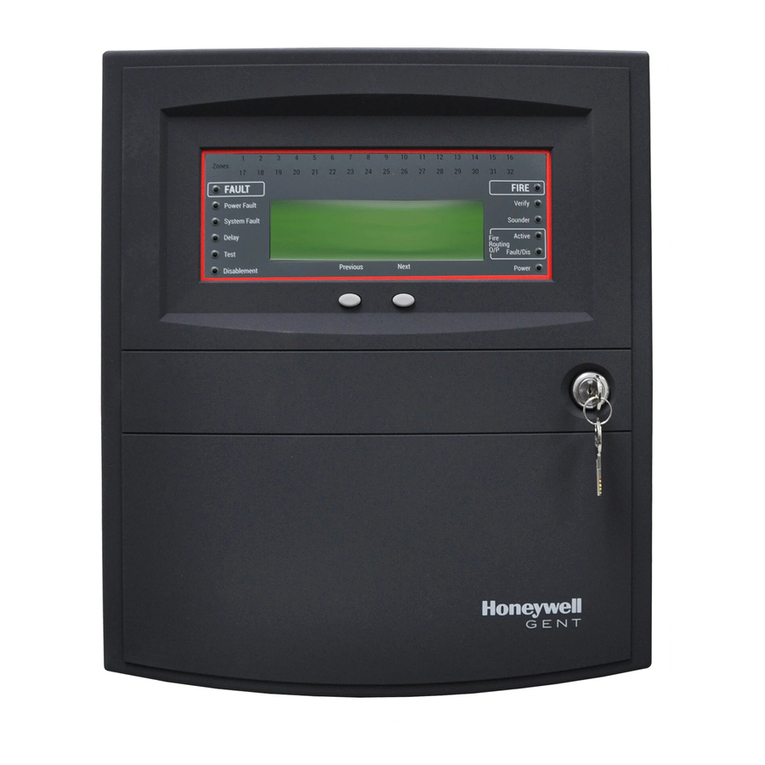
Honeywell
Honeywell GENT operating instructions
